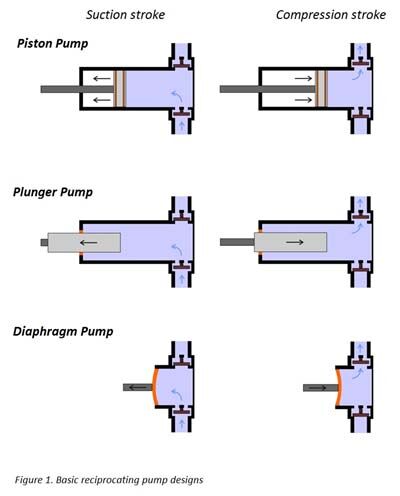Why Use A Positive Displacement Pump
Today, we’re talking about positive displacement (PD) pumps. This is one of the types of positive displacement pumps where the fluid is taken in through the inlet side, captured inside the cavity as it expands, and discharged when the cavity decreases.
This is mostly used by those in the know, because it provides a constant flow at a fixed speed, despite changes in differential pressure.
When should you use a reciprocating pump?
These pumps are often used to transport water, but they are also well suited for applications that pump viscous and corrosive fluids.
In this series, we will be looking at the reciprocating types of these pumps, namely plunger, piston, and diaphragm, before moving on to rotating pumps.
Reciprocating pumps
One type of positive displacement pump is a reciprocating one, so called because of the reciprocating movement this pump is famous for. This motion is a predictable back and forth one (whether it’s a piston, plunger, or diaphragm pump).
When is a reciprocating pump most useful?
We like to recommend the reciprocating pump when you need to provide an exact amount of fluid. This is easily done by modifying the stroke or length of the reciprocating pump for applications that require precise metering and dosing
Three different types of reciprocating pumps:
1. A piston pump
A piston pump comes with an inbuilt piston that is used to pump. This works much like a simple bicycle pump. The first stroke of the pump creates a vacuum, releasing the inlet valve and shutting the outlet valve as it creates a suction effect to draw fluid into the piston chamber. As the motion is reversed, the opposite happens due to the compassion effect that occurs as the inlet valve is under pressure. This pressure causes the inlet valve to close and opens the outlet valve – thereby discharging the fluid in the piston chamber. The bigger the cylinder volume of a piston pump, the more fluid you can pump. Of course, you can get much more complex designs for industrial applications, such as radial pumps.
2. Plunger pump
Plunger pumps work in a very similar fashion, however the volume of fluid moved depends on the size of the plunger. The biggest advantage of plunger pumps is that they may have less wear and tear than piston pumps because the seal is not subjected to the repeated up and down movement of a piston, but is in fact rather stationary.
3. Diaphragm pump
A diaphragm pump has a diaphragm that suctions and expels liquid. To either increase or decrease the pumping chamber and draw or expel fluid into or out of the pump respectively, the diaphragm is either expanded or compressed. The biggest advantage of diaphragm pumps is that they are completely sealed, making them ideal when dealing with dangerous or flammable liquids.
To see how the different types of reciprocating pumps operate, see the diagram below, which lists some of the basic pump designs mentioned (source: : https://www.michael-smith-engineers.co.uk/resources/useful-info/positive-displacement-pumps).

Are you unsure if a positive displacement pump is the right tool for the job, or what type of reciprocating pump you should be using? Call our toll-free number on 1-800-367-4180. We have experts on hand to help you choose, install and maintain a variety of equipment. And to answer questions about things you’ve previously tried gone wrong.
